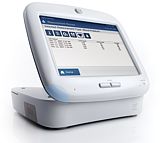
If a company like Intel gets involved you know that providing home health screening devices must be a big opportunity.
Intel Health Guide is designed to be a comprehensive home monitoring service.
- In-home patient device.
- An online interface allowing clinicians to monitor patients and remotely manage care.
- Interactive tools for personalized care management.
- Integrates vital sign collection.
- Patient reminders.
- Multimedia educational content and feedback.
- Communications tools such as video conferencing and e-mail.
- Can connect to specific models of wired and wireless medical devices:
- blood pressure monitors
- glucose meters
- pulse oximeters
- peak flow meters
- weight scales
The Health Guide stores and displays the collected information on a touch screen and sends to a secure host server, where health care professionals can review the information. Patients using the Health Guide can monitor their health status, communicate with care teams and learn about their medical conditions.
Another recent announcement is by Freescale Semiconductor: Here comes an ECG-on-a-chip solution!. The Freescale Electrocardiogram (ECG) Hardware Solution along with Monebo ECG Monitoring Algorithms will allow for low-cost integration of ECG monitoring for remote monitoring and even in home-based devices.
There are many health conditions that would benefit from improved remote monitoring capabilities, but heart disease is certainly at the top of the list and has been shown to reduce hospital re-admissions. Holter monitoring has been around for a long time, but this type of embedded ECG hardware and software technology along with interactive devices like the Intel Health Guide, could significantly raise the bar for ambulatory patient heart monitoring. Companies like CardioNet are already counting on this trend.

It's a good bet that PHR providers like Google Health and Microsoft HealthVault will start to incorporate similar interactive technologies into their offerings. Also, Microsoft offers a device certification program that will draw in more devices. Google has similar developer and branding policies in place (see here).
UPDATE (8/19/08): Tools Help Patients Interface With Doctors which also discusses the Zuri device.
UPDATE (11/10/08): Intel Health Guide Undergoing Trials
UPDATE (12/17/08): Intel Health Guide

Bob,
Actually, Intel is not the first major corporation to confirm with its acquisition pattern that home telehealth is going to be a boom market. Honeywell acquired Milwaukee’s HomMed about three years ago. Prior to that, Bayer and Panasonic joined forces to create Viterion, and Philips Medical has created and staffed a division devoted to remote electronic monitoring of patients. Philips has also been on the acquisition path, getting Lifeline and several others within just the last two years.
Intel actually jump-started its home telehealth path by acquiring a small software company in Atlanta, formerly known as WebVMC, and putting its own finishing touches on that company’s code. Then it developed its own device to run the code and recently received FDA approval for the device.
Pingback: FlashCards English German Pocket PC ·
Pingback: Home Diabetes Testing | Home Health - Home Health Care - Independent Living - Home Care
As a designer and manufacturer of standard and custom friction hinges for among other applications, laptops, this is an exciting new application area for Southco. I am currently researching other players in this space and found your blog to be helpful. You can see more about us at http://www.southco.com/minisites/cema/
Thanks!